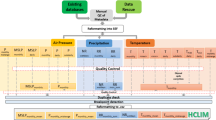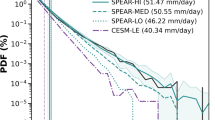Abstract
It is now widely accepted1,2,3,4,5 that the mean world climate has warmed since the beginning of climatologically significant anthropogenic emission of greenhouse gases. Warming may be accompanied6,7,8 by changes in the rate of extreme weather events such as severe storms and drought. Here we use hourly precipitation data from 13 stations in the 48 contiguous United States to determine trends in the frequency of such events, taking the normalized variance and a renormalized fourth moment of the precipitation measurements, averaged over decades, as objective measures of the frequency and severity of extreme weather. Using data mostly from the period 1940–1999 but also two longer data series, periods that include the rapid warming that seems to have begun at approximately 1970, we find a significant increase of 6.5±1.3%(1σ) per decade in the normalized variance at a site on the Olympic Peninsula at which it is low. We place statistical limits on any trend at the remaining 12 sites, where the normalized variance and its uncertainty are larger. At most sites these limits are consistent with the same rate of linear increase as at the Olympic Peninsula site, but exclude the same rate of percentage increase.
This is a preview of subscription content, access via your institution
Access options
Subscribe to this journal
Receive 12 print issues and online access
$209.00 per year
only $17.42 per issue
Buy this article
- Purchase on Springer Link
- Instant access to full article PDF
Prices may be subject to local taxes which are calculated during checkout


Similar content being viewed by others
References
Jones, P. D. & Moberg, A. Hemispheric and large-scale surface air temperature variations: An extensive revision and an update to 2001. J. Clim. 16, 206–223 (2003).
Menne, M. J. & Williams, C. N. Detection of undocumented change points using multiple test statistics and reference series. J. Clim. 18, 4271–4286 (2005).
Trenberth, K. E. et al. in IPCC Climate Change 2007: The Physical Science Basis (eds Solomon, S et al.) 235–336 (Cambridge Univ. Press, 2007).
Hansen, J., Ruedy, R., Sato, S. & Lo, K. Global surface temperature change. Rev. Geophys. 48, RG4004 (2010).
Rohde, R. et al. A new estimate of the average Earth surface land temperature spanning 1753 to 2011. Geoinfor. Geostat.: An Overview 1, http://dx.doi.org/10.4172/gigs.1000101 (2012).
IPCC Climate Change 2007: Impacts, Adaptation and Vulnerability (eds Parry, M. L., Canziani, O. F., Palutikof, J. P., van der Linden, P. J., Hanson, C. E.) (Cambridge Univ. Press 2007).
IPCC Managing the Risks of Extreme Events and Disasters to Advance Climate Change Adaptation (ed Field, C. B.) (Cambridge Univ. Press, 2007).
Coumou, D. & Rahmstorf, S. A decade of weather extremes. Nature Clim. Change 2, 491–496 (2012).
Groisman, P. Ya. et al. Trends in intense precipitation in the climate record. J. Clim. 18, 1326–1350 (2005).
Alexander, L. V. et al. Global observed changes in daily climatic extremes of temperature and precipitation. J. Geophys. Res. 111, D05109 (2006).
Min, S. K., Zhang, X., Zwiers, F. W. & Hegerl, G. C. Human contribution to more-intense precipitation extremes. Nature 470, 378–381 (2011).
Utsumi, N., Seto, S., Kanae, S., Maeda, E. E. & Oki, T. Does higher surface temperature intensify extreme precipitation? Geophys. Res. Lett. 38, L16708 (2011).
Groisman, P. Ya., Knight, R. W. & Karl, T. R. Changes in intense precipitation over the Central US. J. Hydrometeorol. 13, 47–66 (2012).
Epstein, B. Statistical aspects of fracture problems. J. Appl. Phys. 19, 140–147 (1948).
Johnson, L. G. The Statistical Treatment of Fatigue Experiments (Elsevier, 1964).
Doremus, R. H. Fracture statistics: A comparison of the normal, Weibull and Type I extreme value distributions. J. Appl. Phys. 54, 193–198 (1983).
Katz, J. I. Statistics and microphysics of the fracture of glass. J. Appl. Phys. 84, 1928–1931 (1998).
Katz, J. I. Atomistics of tensile failure in fused silica: Weakest link models revisited. SPIE 3848, 2–10 (1999).
Lenderink, G. & van Meijgaard, E. Increase in hourly precipitation extremes beyond expectations from temperature changes. Nature Geosci. 1, 511–515 (2008).
Wong, M. C., Mok, H. Y. & Lee, T. C. Observed changes in extreme weather indices in Hong Kong. Int. J. Climatol. 31, 2300–2311 (2010).
Lenderink, G., Mok, H. Y., Lee, T. C. & van Oldenborgh, G. J. Scaling and trends of hourly precipitation extremes in two different climate zones—Hong Kong and the Netherlands. Hydrol. Earth Syst. Sci. 15, 3033–3041 (2011).
Von Storch, H. & Zwiers, F. W. Statistical Analysis in Climate Research (Cambridge Univ. Press, 1999).
Pali, P. et al. Anthropogenic greenhouse gas contribution to flood risk in England and Wales in autumn 2000. Nature 470, 382–385 (2011).
NOAA US Hourly Precipitation Data http://ols.nndc.noaa.gov/plolstore/plsql/olstore.prodspecific?prodnum=5008 (2011).
Mandelbrot, B. B. & Wallis, J. R. Some long-run properties of geophysical records. Water Resour. Res. 5, 321–340 (1969).
Hasselmann, K. Stochastic climate models Part I. Theory. Tellus 28, 473–485 (1976).
Mantua, N. J., Hare, S. R., Zhang, Y., Wallace, J. M. & Francis, R. C. A Pacific interdecadal climate oscillation with impacts on salmon production. Bull. Am. Meteorol. Soc. 78, 1069–1079 (1997).
Pelletier, J. D. The power spectral density of atmospheric temperature from time scales of 10−2 to 106 yr. Earth Planet. Sci. Lett. 158, 157–164 (1998).
Manuta, N. J. & Hare, S. R. The Pacific decadal oscillation. J. Oceanogr. 58, 35–44 (2002).
Allen, M. R. & Ingram, W. J. Constraints on future changes in climate and the hydrological cycle. Nature 419, 224–232 (2002); erratum Nature 489, 590 (2012).
Acknowledgements
We thank L. Canel-Katz, J. Hoffman and J. G. Miller for comments on the manuscript, P. Ya. Groisman for assistance with the NOAA precipitation databases and Novim for support.
Author information
Authors and Affiliations
Contributions
J.I.K. conceived and designed the study and wrote the paper. T.M. contributed to the study design and writing the paper, carried out the calculations, and analysed the results.
Corresponding author
Ethics declarations
Competing interests
The authors declare no competing financial interests.
Rights and permissions
About this article
Cite this article
Muschinski, T., Katz, J. Trends in hourly rainfall statistics in the United States under a warming climate. Nature Clim Change 3, 577–580 (2013). https://doi.org/10.1038/nclimate1828
Received:
Accepted:
Published:
Issue Date:
DOI: https://doi.org/10.1038/nclimate1828
This article is cited by
-
The future intensification of hourly precipitation extremes
Nature Climate Change (2017)



